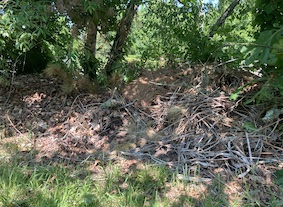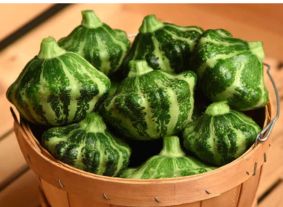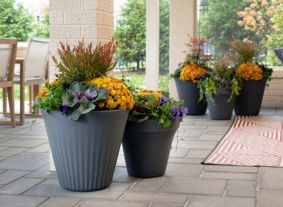Hügelkultur
Views: 227

This summer I am pressing pause on my vegetable garden in order to create a hügelkultur for next season. What’s a hügelkultur? The word means “mound culture” or “mound growing” in German, and it is essentially the construction of a raised bed using stacks of natural debris. You can plant directly into the mound when the structure is complete.
What’s in a Hügelkultur?
Let’s move beyond “natural debris” and talk about the specifics that comprise a hügelkultur. Basically we’re talking logs, branches, twigs, leaves, compost and garden soil. You can plant a vegetable garden, a perennial bed, flowering annuals, and so on directly into the hügelkultur’s topmost layer of soil.
Since moving to this property six years ago, we’ve collected plenty of broken branches, twigs and fallen leaves from yard clean-ups and have tossed it all into a bit of a messy heap alongside the road. Our open-air, slow-cooking compost piles also need to be emptied. We have all we materials one would need to create a hügelkultur in our back yard—even a mound of soil left in the hedgerow by the previous owner. It’s time to put it all to use.
Why Grow in a Hügelkultur?
Now that you know what’s in a hügelkultur, let’s talk about why you’d want to go to all the work of building this structure.
Using your own debris. Like I mentioned above, we will be creating this structure with materials collected from our own property. Not only will we be spending down our debris piles, but we will also be returning the nutrients in those limbs and compost back to the property and soil from which it came. And we shouldn’t have to pay for any additional materials.
Saving water and nutrients. As the wood and compost break down, the process creates water spaces within the materials that help to hold water, lessening your need to water your garden as often. This breakdown also releases nutrients to feed the soil microbiome as well as the plants. That is, you won’t need to fertilize as often.
Poor soil, no problem. My garden’s soil isn’t the best. It’s a bit compact and nutrient poor. Building a hügelkultur on top of it takes the soil’s characteristics out of the growing equation, since the plants will be growing into the pile of decomposing limbs and compost.
It’s above the ground. The hügelkultur is built on top of the ground, or a very shallow trench. After stacking the logs and limbs and then piling on dirt, this structure will be raised 2-3 feet off the ground. This means less bending all the way to the ground.
More planting space. Unlike a raised bed, you can plant along the sides of the hügelkultur, not just along its top surface. It becomes more than a 2-dimensional planting space when you can plant into its sloping side walls.
The general construction instructions say to create the structure several weeks and up to several months before planting to allow the structure to settle and activate. I’ll be creating the structure over the next few months, so check back in to see my progress. In the meantime, you can read more about the origin of the hügelkultur gardening technique on Wikipedia.
Meet Ellen Wells
When you’re raised on a farm, you can’t help but know a thing or two about gardening. Ellen Wells is our expert on edible gardening.…
Ellen's Recent Posts

Green Lightening Squash






